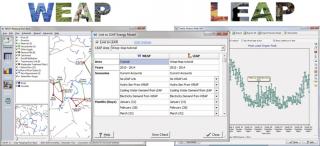Water Evaluation and Planning Model (WEAP)
In addition to conducting research, NCAR scientists and engineers develop tools and technologies to improve forecasts and inform planning and management decisions. One of the most powerful decision support technologies NCAR brings to water resource planning and management is the Water Evaluation and Planning (WEAP) model, developed in collaboration with the Stockholm Environment Institute (SEI). WEAP is a sophisticated, yet user-friendly, tool that couples physical hydrology with relevant water management parameters, set by the user, to create scenarios to explore potential consequences of climate change on water management decisions. WEAP is currently used by several thousand water resource managers in the U.S. and in 170 countries around the world. Use by utility managers in California, Colorado and Florida has demonstrated the model’s ability to capture regional differences in an area’s dominant hydrologic processes. The model has also been proven effective in describing a variety of disparate water-management problems, including costs of capital investment, water law, state and local regulations, and ecosystem valuation, to more fully encompass the many non-hydrological variables managers must consider.
Policy and decision makers, particularly in the Western U.S., have long understood the interconnections between water and energy production and use. Water is needed throughout the energy production system for fuel extraction and processing, power plant cooling, hydroelectric production, etc., and energy is essential for pumping, treating and distributing water. Efforts to address climate change have heightened awareness of these linkeages—the “water-energy nexus”—and of the need to integrate water and energy planning and management. Attention is increasingly focused on water scarcity as conflicts emerge and are likely to escalate over competing water demands for energy production, municipal use, agricultural irrigation, and ecosystem protection. At the same time, energy demand from the water sector—especially for irrigation but also for desalination, water transfers, and water and sewage treatment—has emerged as a serious concern.
While recognition of water-energy nexus issues has grown, tools that can capture the complexity of the relationships between the resources have only recently been developed. Scientists from SEI and NCAR have taken the WEAP model, described above, and coupled it with another model, the Long-range Energy Alternatives Planning (LEAP) system, to create a powerful new integrated planning and decision making tool. WEAP and LEAP can now exchange key model parameters and results and represent evolving conditions in both water and energy systems.
Using WEAP and LEAP together, planners can now explore how individual water or energy management choices ripple through both systems, understanding tradeoffs that might not be apparent when looking at either system alone. They can then evaluate outcomes against their policy goals and priorities, assess costs and benefits, and tweak decision parameters or make other choices to produce more desirable outcomes.
Resources
-
Exploring the water-energy nexus in California via an integrative modeling approach
Description
Yates, D., Mehta, V. K., Huber-Lee, A., McCluskey, A., & Purkey, D. (2021). Exploring the water-energy nexus in California via an integrative modeling approach. Journal Of Water Resources Planning And Management, 147, 04021084. doi:10.1061/(ASCE)WR.1943-5452.0001431
-
Climate change impacts on the water balance of the Colorado headwaters: High-resolution regional climate model simulations
Description
Yates, D., & Miller, K. A. (2013). Integrated decision support for energy/water planning in California and the Southwest. The International Journal Of Climate Change: Impacts And Responses, 4, 49-64.
